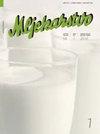乳成分对泌乳中后期奶牛妊娠诊断的诊断准确性
IF 1.1
4区 农林科学
Q3 AGRICULTURE, DAIRY & ANIMAL SCIENCE
引用次数: 1
摘要
本研究的目的是通过评价体细胞计数(SCC)和乳成分(脂肪、无脂干物质(FFDM)、蛋白质、乳糖、凝固点、电导率和pH)在观察妊娠状态中的可用性,建立一个截断点,并确定这些参数作为妊娠状态诊断生物标志物的实际用途。本研究选取初产荷斯坦奶牛133头,分别处于泌乳中后期。牛奶样品在无菌管中收集,用于SCC和牛奶成分分析。各哺乳期SCC、产奶量及乳成分参数根据妊娠情况采用Student’st检验进行分析。采用受检者工作特征曲线确定预测阈值,利用SCC和乳成分参数区分怀孕奶牛和未怀孕奶牛。泌乳中后期所有奶牛的SCC水平相似。泌乳中期妊娠奶牛FFDM、蛋白质、乳糖和电导率较高,产奶量、脂肪、冰点和pH值较低(p<0.05)。泌乳后期,妊娠奶牛FFDM、蛋白质、乳糖和电导率显著升高(p<0.05),产奶量、脂肪和pH显著降低(p<0.05)。脂肪、FFDM、蛋白质、乳糖、冰点、电导率和pH是中期泌乳奶牛妊娠诊断的最佳预测因子,其AUC值分别为0.840、0.768、0.780、0.772、0.693、0.792和0.901。脂肪、FFDM、蛋白质、乳糖、电导率和pH值分别为0.869、0.684、0.661、0.689、0.756和0.841,可作为晚期泌乳奶牛妊娠的诊断工具。综上所述,乳成分可作为一种快速、方便、廉价的荷斯坦奶牛妊娠状态诊断指标。本文章由计算机程序翻译,如有差异,请以英文原文为准。
Diagnostic accuracy of milk components for pregnancy diagnosis in mid and late lactation cows
The aims of this study were to establish a cut-off point by evaluating the usability of the somatic cell count (SCC) and milk components (fat, fat-free dry matter (FFDM), protein, lactose, freezing point, electrical conductivity and pH) to observe the pregnancy status, and to determine the practical usage of these parameters as diagnostic biomarker of pregnancy status. In the present study, primiparous Holstein cows (n=133) were included in the mid and late lactation. Milk samples were collected in sterile tubes for SCC and milk components analysis. In each lactation period, SCC, milk yield and milk component parameters were analysed by Student's t test according to pregnancy status. Receiver operating characteristic curves were used to determine the predictive threshold using SCC and milk component parameters to discriminate between pregnant and non-pregnant cows. SCC levels were similar for all cows in the mid and late-lactation. In the mid lactation, FFDM, protein, lactose and electrical conductivity were higher and milk yield, fat, freezing point and pH were lower in pregnant cows (p<0.05). In the late lactation, FFDM, protein, lactose and electrical conductivity were significantly higher and milk yield, fat and pH were significantly lower in pregnant cows (p<0.05). Furthermore, fat, FFDM, protein, lactose, freezing point, electrical conductivity, and pH were the best predictors for pregnancy diagnosis in mid-lactating cows with the AUC values of 0.840, 0.768, 0.780, 0.772, 0.693, 0.792, and 0.901 respectively. Furthermore, fat, FFDM, protein, lactose, electrical conductivity, and pH could be useful diagnostic tools for pregnancy determination in late lactating cows with the AUC values of 0.869, 0.684, 0.661, 0.689, 0.756, and 0.841 respectively. In conclusion, the milk components could be used as rapid, easily accessible, and inexpensive markers for the evaluation of the diagnosis of pregnancy status in primiparous Holstein cows.
求助全文
通过发布文献求助,成功后即可免费获取论文全文。
去求助
来源期刊

Mljekarstvo
Agricultural and Biological Sciences-Animal Science and Zoology
CiteScore
1.90
自引率
41.70%
发文量
18
审稿时长
12 weeks
期刊介绍:
Mljekarstvo is an open access, peer-reviewed international quarterly scientific journal. The first issue was published in 1951, by the Croatian Dairy Operators'' Association (today: Croatian Dairy Union, publisher). In a paper at a Union conference held 28 October 1951 in Zagreb it was said: "Our desire is that this magazine does not meet the fate of its predecessors, but that it continues to reflect the creative efforts and to provide guidelines for the producers as well as all other operators employed in the dairy industry."
It is our pleasure today to say that wishes of the enthusiasts who attended the conference have come true, and the magazine Mljekarstvo during the last six decades was a reflection of the creative efforts of numerous dairy scientists and experts, and through its texts it served as a guideline in improving production and processing of milk and dairy products. Mljekarstvo has been following all the achievements of the dairy profession in Croatia, and it also gives the short surveys of world achievements. The result of the research of local and foreign scientists and experts always find their place in the magazine Mljekarstvo. It has been edited by our outstanding dairy experts employed at colleges, research institutions and dairy companies.
 求助内容:
求助内容: 应助结果提醒方式:
应助结果提醒方式:


